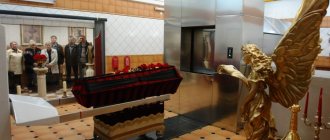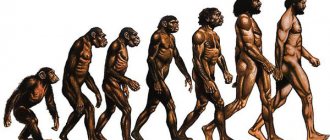The popularity of choosing cremation as a burial method is growing in our time. Now many people are interested in the question: how people are cremated. This happens because people of the modern world have begun to think more rationally, and the traditions of religion have faded a little into the background. With the help of this article you will be able to understand such a difficult issue.
What is human cremation? Cremation is a process where the body of a deceased person is burned. After this, the ashes of the deceased are placed in a special urn or scattered in the air.
History of cremation
The first people to carry out such a process were people in Ancient Greece. They were sure that by burning the dead body they would help his soul in the afterlife.
Additional Information . There is a legend that the first case of burning in the history of mankind was the burning of the body of Buddha, and his remains were laid in various buildings in India.
Buddha statue
Positive aspects of cremation
Currently, the number of bodies cremated posthumously has increased.
What is cheaper: funeral or cremation?
The cost of the burning process is determined depending on what necessary accessories you choose. On average, burning itself costs about fifteen thousand*, in Moscow, for example.
However, the average cost of a traditional funeral is much higher. A standard funeral costs at least twenty thousand rubles*. But this price already includes all the necessary additional accessories.
Thus, it will be cheaper to cremate a deceased person than to arrange a standard funeral process.
*prices are valid for autumn 2021
One look at Rosehill Cemetery in Linden, New Jersey tells you it's in a small town: tree-lined paths, rolling lawns, and signs on every corner. On this summer weekday morning there is a familiar atmosphere of loss and bereavement. A yellow taxi waits for a passenger paying his last respects at one of the graves. A man and a woman in church clothes park their cars on the side of the road and walk to the burial site. An excavator digs a place for a new guest.
This procedure for treating the deceased has long been established. A person dies, he is buried, and a tombstone marks the place of the grave among the rest of those who have passed on to another world. But today I'm heading to a different part of the cemetery where few people go (though that's rapidly changing these days).
This place is called a columbarium, and at first the very existence of such a room with urns for ashes may cause surprise. In films, the urn containing the remains of the deceased usually rests on a shelf at home, or friends scatter the ashes in some sacred place. In real life, many cremated people remain in the cemetery just like their buried comrades.
The floors here are covered with pink carpets. The silence is pierced by the noise of a vacuum cleaner. Along the walls there are rows of small niches with urns of different sizes and types, each in the spirit of its time. Older urns are distinguished by their sophistication of style: one is crowned with an eternal flame, the other is made in the shape of a Bible. The urn with the inscription “Henrietta Leiber, 1866-1933” is made in the shape of an acorn. Next to her is a photo of Henrietta in a white sleeveless dress and long pearl earrings, her hair cut short, like a ditzy girl of the 1920s.
Modern urns are simpler in shape and style. In addition, they are bulkier, but not out of vanity. During the cremation process, more of a person's body remains than before. Some families decorated the niches with flowers, family photographs or pictures of Jesus. Others left the niche empty and placed the urn behind a marble slab. There is some irony in this: the body was destroyed down to the smallest organic particles, in order to then surround it with stone for protection.
Today we are witnessing a radical change in the perception of death and what follows it. Over the past few decades, the number of Americans choosing cremation over outdated burial has increased dramatically. This is what brought me to Rosehill Cemetery, and now, together with Jim Koslowski, director of Rosehill and Rosedale Cemeteries, I set out to delve into his world and learn how the work of cemeteries is changing in the face of a radically new way of thinking about death and burial.
We move further into the columbarium and pass through the Pink Room. Here the ballot boxes are not hidden behind glass, but are open for public viewing. I like this approach better: glass boxes resemble display cases in pharmacies, where without a salesperson with a key, there is no access to goods. At the far end of the room are doors made of stained glass. Koslowski pushes them aside, revealing another door, this time made of iron, like in spy movies. They are so strong for a reason: next is the crematorium itself.
We're going in. The room resembles a factory, the purpose of which is a special type of destruction.
Socially acceptable
In 1980, less than 5% of Americans were cremated after death. That figure is now up to 50%, according to the Cremator Association of North America. The reason is undoubtedly changing cultural and religious norms. But if you want to understand what accelerated the changes, just remember the Global Economic Crisis.
“The increase in the number of cremations began with the advent of the crisis in 2008, when many people were left without work. It’s not as expensive as burial,” Koslowski explains.
“Not that expensive” is putting it mildly. Cremation at Rosehill costs just $180, although the urn, flowers and other services are extra. By comparison, a cemetery plot can cost up to $2,500, plus a $1,500 surcharge for digging the grave with an excavator.
Rosehill is a half-hour drive from Manhattan and today cremates about 25 bodies a day, a number that is increasing to meet growing demand. The crematorium already had three cremation installations, two more were purchased in 2013 and 2021, and by the end of the year it is planned to purchase and install the sixth.
Of course, burning the dead is not a new phenomenon - people were sending people on their last journey long before the crisis forced Americans to save every penny. Cremation began in the Stone Age. It was also a tradition, although not universal, in Ancient Greece and Rome. In some religions, such as Hinduism and Jainism, cremation was not only permitted but also preferred.
The rise of Christianity brought an end to the practice of cremation in the West. Already in 330 AD. e., when Emperor Constantine declared Christianity the official religion of the Roman Empire, cremation, considered a pagan rite, was banned. The reason for the ban was related to the idea of resurrection - it is better if the body is preserved whole or in one place. During the Reformation, the Catholic Church, to put it mildly, did not approve or even prohibit cremation, but burning was used as a punishment or for hygienic reasons. In Judaism, cremation was also prohibited. By the 5th century, cremation had ceased to be used completely in Europe.
Cremation returned to Europe in the 1870s, largely due to public health concerns to curb the spread of disease. The first modern crematorium was built in the USA in 1876, and the second - 8 years later. By 1900, there were already 20 of them. A new rise in popularity came in 1963, when the Catholic Church, during the Second Vatican Council, radically changed its opinion on cremation. Now it was resolved, but the scattering of ashes was not.
Today, there are more than 2,100 crematoria in the United States, and the return of such a practice is due to more than just cost. Fewer religious prohibitions and changes in client preferences have an impact: people want simpler and less ritualized funerals. The high pace of modern life also takes its toll, says Robert Biggins, owner of the Magoon-Biggins Funeral Home in Rockland, Massachusetts. “People don’t stay in their hometown for life. We are much more mobile. Generation X and Millennials change jobs every 5-7 years.” Americans don't want to stay in one place even after death.
Fergananews 11/13/2017 Aftonbladet 10/31/2017 Süddeutsche Zeitung 10/25/2017 Ghanoon 09/09/2017 Foreign Media 02/28/2018 Neue Zürcher Zeitung 05/24/2017 Publico 03/31/2017 Simply put, cremation has become socially acceptable. Acceptance rates vary by state and ethnicity, but in California, Oregon and South Florida, 60 to 80 percent of deceased people are cremated, according to a report from the Funeral Industry Association. The number is significantly lower in the Bible Belt region and in some other population groups, including Catholics and African Americans.
There is another point that promotes cremation as an alternative to burial. “There are fewer and fewer places in cemeteries,” explains Koslowski. According to his estimates, within 15 years there will be no places at all in Rosehill. It is therefore not surprising that many cemeteries install crematoriums. Although this causes dissatisfaction, especially in residential areas.
“There are stereotypes about this,” Koslowski explains. “There are still people who consider crematoria vile and disgusting institutions.” They don't want something like that next to their home."
How does a crematorium work?
Koslowski and I walk through the double doors. As soon as we enter the crematorium, a signal sounds.
“Why is it needed?” - I ask.
“It means there might be a hearse approaching the door. This signal alerts busy employees that someone has arrived,” he replies.
The bodies are delivered in wooden or, most often, cardboard coffins, in which they remain during the entire cremation procedure. This is for medical reasons and protects employees from infections. There are also ethical reasons: Koslowski says that "families want something to put their dead relatives in." It also makes sense from a logistical point of view: “Without a coffin, it would be extremely difficult to load the remains. Imagine a human body and try placing it in a cremation facility.”
There is a refrigerator at the crematorium. The coffins are delivered there and placed on shelves. On one of them I saw a Delta Airlines tag that said: “Human remains. We don't care." Typically, the bodies of the deceased are refrigerated for 1-2 days because most states have a law requiring at least 24 hours to pass between death and cremation. When something so fatal happens, there is no need to rush.
Five large cremation units occupy an entire floor. The equipment is coated with diamond-coated aluminum, the kind of coating you might see on a fire truck or a professional toolbox. By the way, this is called “cremation equipment”, not “oven”. And you shouldn’t call cremation the burning of corpses, even if this is essentially true. There are words that should not be said in the crematorium.
“The word 'oven' has a negative connotation because it is associated with Auschwitz. People try to avoid that term,” says Brian Gamage, director of marketing at US Cremation Equipment in Altamonte Springs, Florida.
When the body is ready for cremation, it is removed from the cold storage room, placed on a gurney and taken to one of the cremation facilities. Mistakes are unacceptable and unforgivable when cremating, so Rosehill double-confirms the identity of the deceased to ensure the family receives the urn containing their relative's ashes and not someone else's. A copy of the payment receipt is affixed to the outside of the cremation facility, and a metal identification tag, similar to an army dog tag, is placed on the body itself.
The door to the cremation chamber opens 75-90 centimeters, but most employees open it only 30 centimeters: just the width of the body. If opened wider, the room will become unbearably hot, which could harm the employee. The body is placed in the cremation chamber by pushing with a special tool or by hand. There are rotating cylinders on the gurney, and sometimes inside the cremation chamber, so the coffin can slide into the cremation chamber with ease.
The cremation facility consists of two chambers: the primary one, where the body is located, and the secondary one, where the resulting gases are burned.
The walls of the primary chamber are lined with brick, and the floor and roof are made of high-strength fire-resistant concrete. The burner is located on the ceiling and heats the chamber to approximately 650 degrees Celsius. At this temperature, the body breaks down into gas and bone fragments.
The resulting gases and bone fragments move to the next chamber: this is a nine-meter labyrinth in which the gas is held for about two seconds. In the secondary chamber, the gas and bone fragments are heated to 900°C to crush them and destroy the odor, after which the gas is released into the atmosphere. Gamage says the aftermarket chamber is similar to the exhaust converter on older cars: it cleans up emissions from the exhaust system.
“Any solid turns into a gas if it is heated to the right temperature. Essentially, this is what happens to the body: the tissue heats up to the point that it turns into gas, explains Gamage. — Any combustion, be it burning fuel in a car or cooking food on a grill, necessarily entails air pollution. When designing equipment for crematoriums, great care is taken to ensure that emissions comply with government environmental regulations.”
According to most state environmental agencies, particulate matter emissions must be less than 0.06 grams per cubic foot. Difficulties arise when gases accumulate in the secondary chamber and the concentration begins to exceed permissible limits. This occurs if the equipment is not designed properly or if an employee overloads the primary chamber. Overloading the primary chamber occurs for unexpected reasons: for example, if an overweight person is placed in it without taking into account the schedule of other cremations.
It sounds creepy, but the crematorium staff really care about the weight of the deceased. The equipment does not understand the difference between 70 and 180 kilograms and simply performs its functions. Workers know for sure that to burn 45 kilograms of human fat you need 64 liters of kerosene. If you need to cremate a body that weighs 180 kilograms, then at least 90 of them will be fat tissue, which burns out quite quickly. If you place such a person in an overheated primary chamber - overheating of the equipment often occurs after several hours of continuous cremation, by the end of the working day - smoke and an unpleasant odor will pour out of the chamber.
“The equipment can’t handle that volume of gas,” Gamage explains. “Most experienced staff cremate these bodies early in the day, when the cremation facility has not yet overheated.”
At Rosehill Crematorium, I stare at a computer monitor that reduces the ritual of cremation to raw data on a monitor. This is the second cremation today. The body inside is a man in a cardboard coffin, weight category - from 90 to 260 kilograms. The procedure lasts for an hour and twenty minutes. An on-screen diagram displays data from both cameras. Three small blue lights under one of the chambers indicate that additional air is being supplied to the primary chamber for cooling. Before this, the temperature inside the primary chamber was 870-980°C, but now it has dropped to 490-620°C.
In general, it takes about one and a half hours to cremate a body, with slight variations depending on the weight of the person and the type of coffin. Time commitments limit the number of cremations per day. All five cremation facilities were operating during my visit. In eight hours, one cremation unit can cremate five bodies. Rosehill Crematorium is open six days a week, with equipment being idle only on Sundays.
“For religious reasons?” I ask Koslowski.
“No,” he says. “We just need a day off.”
Close to home
Lisa Tomasello grew up in a large Italian Catholic family. In those days, the death of a relative was followed by two or three grueling days. In the next room, visitors entered their names in the guest book and stood in line at the coffin of the deceased. They sat in front of the body of the deceased, knelt, prayed, crossed themselves, kissed the deceased’s hands, face and lips. “The closer the relationship was, the closer to the lips,” explains Lisa.
Close relatives sat in the front row, receiving those who came to say goodbye to the deceased. Sobs and lamentations in Italian were common. At noon, the family went to lunch, where everyone told stories and laughed, before returning to the funeral hall to spend several more hours crying. Then the funeral: the process begins in the funeral hall, continues in the church and ends in the cemetery, after which guests are invited to the wake.
The body was buried, a tombstone was erected, and then what? During each period of mourning, Tomasello asked herself this question. In the first few years, you may go to the cemetery, but most likely the next time you will be there is when another relative of yours is buried. “There hasn’t been anyone at my grandparents’ grave for over 30 years,” she says.
Tomasello grew up, and when her own parents left this world, she wanted to change the standard mourning ritual. When her mother died, Lisa and her siblings decided to have a small ceremony and have her body cremated. A few years later, his father died; this time they forgo a formal ceremony, drank a glass of Jack Daniels in honor of their father, and then cremated him and divided the ashes between themselves.
“It comforts me that my parents’ ashes are in my bedroom. I don’t feel guilty that I haven’t been to their grave for a long time - they are here with me.”
We find it difficult to let go. We want our departed loved ones to be close to us. Sometimes we even humanize things that remind us of them. This is a way to bring loved ones back to life. No, an urn is not just a container containing your mother’s ashes. The urn is the mother.
To perpetuate the memory of my father, I bought a bench and placed it on the sidewalk in my city. Now this bench reminds me of my father. When I greet the sunrise and see the silhouette of a bench, I feel as if he is greeting it with me.
What remains?
It's not easy to say, but the physical characteristics that come to mind when we imagine our loved ones - their eyes, skin, hair - disappear without a trace during the cremation process. After all that we go through - experiences, memories, suffering and pain, exams passed and facts learned - the largest part of the remains of the deceased after cremation is the coffin. “Typically, cremated remains consist of fragments of the deceased’s bones and ashes from the coffin. Don’t forget, we are 75% water,” explains Koslowski.
After the procedure is completed, the cremated remains are placed on a silver tray. Using a magnet, a crematorium employee collects unburned metal objects. These can be staples, screws, hinges and dentures. Then they manually select what the magnet missed - say, shards of glass from a bottle of whiskey with which the children wished to cremate their late father. All this is buried somewhere in the cemetery.
"And what's that?" — I ask, pointing to the tray with the remains.
“One of the bone fragments. Possibly an intervertebral disc,” Koslowski replies, adding, “here you can check the anatomy.”
"But it's green."
“I don't know what's wrong. This may be related to the medications you are taking. Hard to tell. It might have been cancer."
The remaining bones and ashes are placed in a grinder, not unlike a kitchen mixer. The remains are then passed through a sieve and sealed in a container for the family, although this is not always the case. Representatives of some Asian cultures want to independently extract the uncrushed remains of the bones of the deceased. The skull and pelvic bones are especially prized. Such families are categorically against shredding.
Hindus often want the cremation process to be initiated by the eldest son as a rite of passage, so he is allowed into the crematorium to turn on the installation. Every week, about a dozen families express a desire to watch the cremation process. Rosehill provides a viewing platform for such occasions. Koslowski said it's important that people understand the process and don't doubt cremation because of misinformation or gossip.
“[Some] believe that several people are cremated at the same time and the coffins are resold. Whatever. People watch the news."
I press him for the truth about urban legends about crematoria. Which of these is true? Do the remains of some cremated people mix with others? My interlocutor explains that everyone is cremated separately, and the installations are thoroughly cleaned after the procedure.
Still, Barbara Kemmis, a spokeswoman for the Cremator Association of North America, comes to mind that even though units are cleaned between cremations, tiny particles can get stuck in tiny cracks in the unit's brick walls and concrete floors and accidentally end up in the remains of another cremated person. This is perhaps one of those aspects of cremation that it is best not to think about.
Unburied
Cremation, like death, is final. And yet this does not exclude subsequent doubts. Susan Skiles Luke, a marketing consultant from Columbia, Missouri, had her mother cremated and buried her remains in the family cemetery. Now she regrets that it is not the body that lies in the grave, but only the ashes of the deceased.
“When I visit her, which is not often, I want her body, dressed in her Saturday best, to lie underground with the bodies of my late grandparents and beloved aunt, and not as a heavy shoebox filled with something similar to cigarette ash,” she laments.
When her older brother, with whom she was very close, tragically died of an overdose 13 months later, cremation instead of a traditional funeral seemed like a godsend. “If you are still angry—perhaps someone close to you has passed away, like my brother—cremation avoids public drama, display of the body, or discussion of the circumstances of the death. You can think about the logistics of the “body” later, when you come to your senses,” says Susan.
The undoubted advantage of cremation is that it allows you to resolve emotional problems in a way that is convenient for you. What about the shortcomings? You get the remains, a tangible object loaded with memories. After her brother's death, Susan picked up his ashes on the way home from work, as if it were an everyday matter. After all, the funeral home was on the way home. “How thoughtlessly I acted in not entrusting this matter to someone else, because I had never done this before. I didn't expect it to affect me so much. I threw the ashes into the trunk with a roar and roared all the way home,” the girl recalls.
A few years later, when her stepfather passed away, she was unable to pick up the remains, even after several calls from the funeral home. “I never picked up the phone. I listened to one voice message politely reminding me to “pick up my father.” That phrase, combined with the fact that 'my father' was just a handful of ashes in a box, reminded me of when I collected the remains of my brother Tom."
One day she returned home and found a box with her father's ashes on the doorstep. Now the two boxes containing the remains are in a warehouse somewhere, although she doesn't know where exactly. She asked her husband to hide them so that she could not see them. “Not the healthiest reaction,” she admits.
Ellen Herman, who works in digital advertising in Los Angeles, found herself in a similar position. About nine years ago, both her parents died within a year of each other, after which they were cremated. She decided to head to the mausoleum in Florida, where her parents lived shortly before their death, to find a place for their ashes and honor the memory with warm words. In any case, this is exactly what she intended to do, but she never carried out her plan.
“They are at my house. Actually, right in my bedroom! In boxes under a pile of all sorts of rubbish. I kept them in the garage for a while, but that also didn’t seem right,” she says.
Some of their remains, together and separately, are located in different places. His brother keeps some of his father's ashes, but most of them are in boxes at Ellen's house. “None of my brothers wanted to take the ashes for themselves, and it seemed wrong to me to scatter them. I think because families don't live as close together as they once did, the importance of visiting a cemetery has diminished, but I still find keeping ashes in boxes in the bedroom completely disrespectful to the deceased,” Ellen shares.
Sometimes, instead of burying our loved ones in the ground, we bury them under a pile of things. We lose them among other emotionally charged attributes of our life, because it is not easy to survive.
Interment
We came from the earth, and we will go into the earth. Nobody argues, the only question is whether we will harm the environment while we leave. Cremation is increasingly competing with funerals as the most common post-mortem ritual, and there are serious concerns about the procedure's contribution to environmental pollution. Some are even beginning to look for more sophisticated ways to dispose of human remains.
Alkaline hydrolysis technology is being promoted as a more environmentally friendly alternative, which releases less carbon monoxide and other harmful substances into the air. In alkaline hydrolysis, the body is placed in a chamber filled with water and potassium hydroxide, and then heated under high pressure to a temperature of 160°C. After three hours, the soft tissue turns into a dirty green liquid, and the bones become soft enough to be crushed. The bones are usually given to the family and the liquid is poured down the drain.
Just technology for some dystopia, right? It seems so for good reason: it was invented for the disposal of livestock affected by mad cow disease. When European farmers had to slaughter huge herds of sick cows, they dumped the carcasses of the animals in pits, doused them with gasoline and burned them. With the advent of alkaline hydrolysis in 1990, six-meter stainless steel tanks began to be produced for this purpose. High pressure during alkaline hydrolysis destroys prions - protein particles in the brain of cows responsible for the occurrence of rabies. As the years passed, some companies began to market alkaline hydrolysis as an environmentally friendly way to dispose of human remains. “They took existing technology and applied it to the cremation field,” says Gamage of US Cremation Equipment. “Capitalism in its purest form.”
The technology is not popular, and no wonder: it is slow and expensive. A stainless steel device can cost from $175 thousand for the basic configuration to $500 thousand for the most advanced model. For comparison, prices for cremation facilities range from $80 to $100 thousand. There are also legal complications: the use of the technology is prohibited until the state government issues the appropriate legislation.
Disgust also plays a role. Let's not forget that we are talking about making a thick soup out of the human body and pouring it down the drain. The idea may still be attractive to those who don't want to think about incineration, but most have a hard time coming to terms with how the byproducts of alkaline hydrolysis are disposed of.
Pragmatic about death, Koslowski sees it differently.
“People think like this: what is happening, not only did they dissolve my mother, but now they will also pour her into the sewer?! They can be understood. But, say, during embalming, body fluids are also poured out. No difference".
Material evidence
In movies, you can often see characters scattering the ashes of a loved one: some from the deck of a ship, some from the top of a mountain. In reality, this rarely happens. The Cremator Association of North America estimates that 60-80% of cremated remains are retained by relatives. Someone decided to take the remains to the cemetery or scatter the ashes a little later. So the ballot boxes remain at home.
“The news recently showed people trying to find the ashes of relatives after a fire, flood or landslide. So a large percentage of remains are kept in people’s homes,” Kemmis concludes.
Places where it is permitted to disperse the contents of an urn are regulated by law. For example, in Massachusetts, the law requires that ashes be scattered “with respect.” One wonders what this means. Biggins of Magoon-Biggins Funeral Home says, “What I mean is, you can't just throw ashes all over Main Street or put them in front of your neighbor's garage. But there's nothing wrong with having a ceremony on the golf course where your father played for 40 years."
Scattering the ashes of a loved one to the wind is a romantic idea. However, there is also a point in allocating a special place for the deceased and writing his name there.
“We place headstones on the graves of loved ones to preserve their memory,” says Biggins. His wife died tragically at the age of 57, and he often visits her grave. Her name alone can comfort him a little. “Many people leave pebbles and coins on the gravestones. I go there every week, there are already several dozen of them there. It makes your soul feel so warm when you see that people don’t forget about her.”
Just as I'm about to leave, I decide to stand at the grave of my friend David. He grew up in Harlem and had a hard time in life.
Mother is an alcoholic. The father left the family. Despite his living mother and grandparents, the boy was still being dealt with by child protective services. He was educated in a public school in Cortland County and was able to attend the State University of New York on a football scholarship. He studied for only a semester and returned to Harlem. What happened next was like something out of a bad movie: I met a girl, tried crack, lost my job, became infected with HIV. As a result, kidney problems arose: I had to live on dialysis for ten years. He died in 2015 of heart failure, one of the first on the list to receive a donor kidney.
I was at his funeral ceremony, but I never made it to the cemetery where I’m standing now. It's time to fix this. They give me the “address”: section 48, row 24, grave 83. The cemetery is very large, but, having found the right section, I quickly find his grave. To my surprise, I see only a piece of land and the number 83 on the concrete - no sign that David is buried here. On one side of his plot are large marble tombstones, on the other, inside a wire fence, there are a bunch of plastic flowers, pieces of blue ribbons and strings, foam crosses with the words “I love you” and a deflated white balloon. It’s as if yesterday there was a holiday at the neighboring site, and David was not invited.
This is somehow unfair, I thought. He treated people very well: to me, and to his girlfriend, a drug addict, and to his niece from Florida, to whom he sent money, although he had practically no money himself. Without a tombstone, no one will ever know that he is down there somewhere. Or rather, that he was once up here.
Neither a funeral nor cremation gets rid of the most difficult thing - you need to let a loved one go from this world to another. People need material evidence that the deceased once walked the Earth with them. It doesn’t matter which ones: a tombstone, a bench, or an urn will do.
I approach the car and in the back seat I see a figurine of a football player, which my son dug up in some trash. I take a black marker out of the glove compartment and write on it: “David. April 23, 1954 - April 23, 2015." I return to grave 83 and place the figurine in the place where a tombstone could stand. She left a pebble on the grave, as they sometimes do, and went to the car.
Translation of the project Newabout
InoSMI materials contain assessments exclusively of foreign media and do not reflect the position of the InoSMI editorial staff.
Cremation and religion
Different branches of religions have completely different attitudes towards the burning of the dead. In Orthodox Christianity, for example, it is believed that after bodily death, the soul will continue to live next to God. And in this religion the body is treated as a temple of the soul, even after death. Therefore, the attitude of the Orthodox Church towards the cremation process is not very positive, but not negative either. The way cremation is carried out is contrary to Christianity. Orthodox Christians do not believe that there will be any harm to the soul in any burial process.
In the religion of Islam, the cremation process is treated as a violation of primordial traditions. Although many religions have undergone some changes, Islam has retained its original essence. That is why the regulations regarding death have remained unchanged to this day.
In Hinduism, Buddhism and their other branches, cremation is the traditional way of burying dead people. In Buddhism, the main bliss after death is the achievement of nirvana. And it can be achieved only by separating carnal and spiritual life. This is what burning bodies are used for, which means cremation.
What are the advantages of this method of burial?
At different times, attitudes towards cremation varied significantly. At one time, people preferred burial in the ground, and at another they chose to burn bodies. Today, cremation is a common, environmentally friendly type of burial of the dead. Gradually, religious traditions are fading into the background, and people are thinking more rationally and making a choice in favor of a “green alternative”.
The main advantages of cremation include:
- Availability. Burning bodies in a crematorium is cheaper than a traditional funeral. Relatives practically do not need to spend money on ritual goods, with the exception of the coffin and urn. For cremation, the simplest domovina is suitable, which will be burned along with the body.
- Environmental friendliness. During the procedure, the body turns into a fine powder that does not pose a danger to the environment. It takes about 2 hours to burn, while the remains in the ground decompose for many years, and substances from decomposition end up in groundwater.
- Convenient storage of ashes. The ashes are placed in a small urn weighing several kilograms. It is easy to transport. In the crematorium building, the ashes of the deceased can be stored for up to 1 year, including a free storage period (different for each crematorium). Traditional burial, unlike cremation, requires lowering the deceased into the grave within the next few days after death.
- Psychological aspect. Funerals are always exhausting, both mentally and physically. Even if the deceased was cremated, mourning ceremonies, farewells, and funeral services are still held. It all depends on the wishes of the relatives of the deceased.
How a person is cremated in a crematorium
This process is carried out in specialized engineering structures that are designed to ensure that the corpse burns completely.
In order to cremate a person, you need to contact special organizations that deal with this. Moreover, some funeral companies are engaged in both traditional burial and cremation.
Documents you will need for cremation
- Death certificate, which can be obtained at the nearest MFC or registry office.
- Passport or any other identification card of the person who organizes the cremation process of the deceased.
- Agreement on the provision of cremation services by a funeral organization.
- Cash receipt for payment of services.
How much does ashes weigh and what does it look like?
Modern, technologically advanced crematoria of a new type make it possible to obtain environmentally friendly ashes that are not subject to further decomposition and do not harm the environment. The ashes of a person are given to relatives in a special vessel that is securely sealed. Externally, the ashes look like a homogeneous grayish mass, but heavier, like ash.
The ashes include the coffin and clothes of the deceased, which burn and turn into ashes. The weight of the ashes of foreign objects can be twice as much as the weight of the ashes of the deceased himself. On average, the ashes of a person weighing about 70 kg are 250-300 grams, which is identical to 2-2.5 liters.
How is the cremation process carried out in today's world?
This type of burial is in demand in Japan, the Czech Republic, the USA and the UK.
Description of the stages of cremation, their features
Farewell to the deceased in the crematorium
- The coffin with the body is delivered to the crematorium.
- The coffin is placed in the hall so that relatives can say goodbye to the deceased.
- After this, the coffin is moved to a room where it will be transferred to the cremation oven.
- The corpse is burned.
- The ashes are placed in a metal urn. To prevent mixing of ashes from different corpses, each body is registered. An iron plate with a number is attached to the coffin. After burning, the plate remains among the remains and one can understand whose ashes it is.
- After the process, the urn is stored for a year until a relative picks it up.
Human body cremation ceremony
In the farewell hall, a coffin with the deceased is placed on a pedestal. Relatives have the opportunity to spend time with the deceased - this is the most significant moment in the funeral procedure. The creation of a mourning atmosphere is facilitated by the sound of musical compositions, which are ordered by relatives on the eve of cremation or chosen by employees of the institution. In large crematoria, farewell to the deceased occurs simultaneously in several ritual halls, decorated with paintings with religious subjects, vases of flowers and other interior elements. The music is recorded or performed by cellists and organists who work at the institution.
Cremation in modern Russia
At the moment, the cremation procedure is not very popular in Russia. This is due to the fact that there are not enough crematoria where such a process could be carried out. Now, for example, in Russia there are only 15 crematoria.
But the popularity of choosing cremation as a burial method is growing. This is due to several reasons:
- Burial of the remains of the deceased will take up much less space in the cemetery.
- People often find the cost of cremation the most attractive.
- Followers of a particular religion choose cremation according to their beliefs.
Cremation assistance from
The funeral service "Honest Agent" is ready to provide comprehensive services for the procedure of cremation of the body and burial of the urn in Moscow. Our specialists know well how a person is cremated in a crematorium and perform their work at a high professional level. When organizing a funeral, we perform:
- preparation of necessary ritual accessories (coffin, urn, wreaths, flowers, etc.);
- delivery of the deceased from the morgue to the crematorium;
- preparation of necessary documentation;
- transportation of the urn from the crematorium to the burial place (to the cemetery or columbarium);
- organization of funeral services and commemorations.
Agency employees carefully monitor all stages of the funeral ceremony and do everything to ensure that the funeral is as dignified as possible. We understand how important it is for relatives to comply with all funeral requirements, therefore we approach our work responsibly and fully take into account the wishes of loved ones.
Tell your friends:
Features of the crematorium
You choose the type of coffin, preference is given to wooden. You pay the check and wait for the cremation procedure.
On average, the cremation process lasts about an hour. The time depends on the material from which the coffin for the deceased was made. The burning temperature ranges from eight hundred to a thousand degrees, it is determined by how quickly the corpse is burned.
The crematorium employee wears specialized clothing - these are thick gloves, a face mask and a protective suit.
The ashes have no particular odor. All biological components burn and cannot emit odors.
When organizing the cremation procedure, it is also worth taking care of transportation services, if you need it.
Doors to the oven in the crematorium
Despite different opinions, there is still a certain size limit that can fit in the oven. It also depends on weight.
Cremation oven
Most modern cremation ovens consist of two chambers: in the first chamber, a stream of hot air burns the coffin with a corpse, and in the second chamber, organic tissues and impurities are burned. From there, the body is sent to a cremator, where the remains are crushed to ashes, after which magnets remove the metal parts. Most cremation ovens run on gas. To make it easier to identify the ashes, a metal plate with the identification number of the deceased is placed on top of the coffin when it is sent to the oven. After burning, this plate ends up in a heap of ashes - this is how it is identified.
What happens to the ashes after burning?
After the cremation process, there are several ways to proceed. If relatives take the ashes, then there are the following options for further actions:
- One of them is the burial of an urn with ashes in the grave.
- Another popular method is to scatter the ashes in the air.
- You can also take the trash bin to your home and designate a special place for it.
- Place the ashes in a columbarium. This is a storage area for urns with ashes. More often it looks like a wall with cells in order to place an urn with the remains of the deceased.
Urn for ashes
If no one has taken the ashes of the deceased within a year, they will bury him in a cemetery.
Cremation or cremation
Cremation is a process itself. When we say “cremate”, it means to undergo this process. In general, it is more correct to call the process of burning a body cremation, and use “cremation” in the form of a verb, that is, say “cremate.”
Human Cremation: How people are cremated.
It is important to understand that cremation is only the first stage of burial. Depending on the will of the deceased/relatives, after cremation, the urn with ashes is placed in a niche of the columbarium, buried in a grave, or done in another way (for example, the ashes are scattered).
During cremation, as during burial in the ground, the process of transition of organic tissues into inorganic chemical compounds that make up the soil occurs. Cremation is essentially the same as burial, since the body goes into the ground. There is only one difference: mineralization of the body and its inclusion in the soil takes up to 20 years, and cremation of a person reduces this period to one and a half hours.
Residents of Russia increasingly prefer cremation to the usual method of burial. The share of cremation in Russia as a whole is low - 10%, but in large cities it is 30-40%, and in Moscow and St. Petersburg it is close to 70%. This happens for many reasons, the main ones being the lack of space in cemeteries, the simplicity of the process and low cost.
Rules for transporting an urn with ashes
When planning how to transport a vessel with ashes using any means of transportation, you should take care of how sealed the vessel is.
If you choose an airplane for transportation, then the action plan is as follows:
- You need to pack the urn well.
- Tell the airline what you plan to take with you.
- To transport a vessel, you need to fill out a declaration.
- You are also required to provide the airline with a death certificate of the deceased whose ashes you intend to transport.
To transport this baggage outside of Russia, you need to obtain permission from the consulate of the country to which you are going to fly with the ashes. But first you need to find out whether it is even possible to transport the urn in this direction. Next you need to pay for the transportation of the urn. Costs may vary between airlines.
Now you can calmly and without unnecessary problems contact the funeral company with the registration of all the above, which will prepare all the necessary documents for you. This service is not free, of course.
Burning the body
Initially, the body is moved to a transit room, where it remains until it is transported to the cremation oven. When burned, the remains are exposed to a column of fire, which first dries out the soft tissue, then the muscles, hair and skeletal structure. The gases released during combustion are discharged through the exhaust pipe. All emissions are treated with special compounds, so there are no unpleasant odors in the crematorium area.
The time it takes to burn can depend on many factors:
- dimensions, weight of the deceased;
- body fat percentage;
- temperature in the chamber;
- cremation oven performance;
- the type and material of the coffin in which the deceased is located.
If, after the formation of ashes, there are foreign elements in it (metal buttons from clothes, implants, dental gold, etc.), they are removed using forceps or magnets. Pacemakers are removed during the autopsy in the morgue, since they can explode in the oven. Finally, the ashes are treated with a cremulator - special equipment that further crushes the remains.
What happens to the human soul after cremation.
Many people ask themselves this question. The answer is ambiguous if you choose religion as an argument for the answer. Each belief interprets life after death differently.
In Christianity, the soul goes through the Last Judgment, where, depending on how righteous a person followed a life, the soul goes to Heaven or Hell.
In Islam, it is believed that when a person lies on his deathbed, the messenger of Allah, the Angel of Death, comes for him. In this religion, it is traditionally believed that how easily death passes depends on the life a person led. An easy and unnoticed death awaits the righteous. A painful and long death awaits sinners. Next, the soul goes through the Judgment, after which it goes to Heaven or Hell. However, if a Muslim sinned but was devoted to Allah, he can atone for his sins and go to Paradise.
In Buddhism, it is accepted that the following fates can await a soul: samsara, that is, transmigration of souls; going to hell before being transferred to a new soul; finding nirvana. Finding nirvana is the completion of the cycle of life and rebirth. That is, all Buddhists should strive to achieve it.
In conclusion, it can be argued that the process of burning a body after death does not seem to be something forbidden, as it was previously for the majority of the population. Cremation seems to people to be a less expensive and more lyrical process. A huge number of people would rather have their body scattered through the air than simply left lying in the ground.
Wall of Sorrow: Columbarium
The tradition of preserving the ashes left after burning a body appeared in Ancient Rome. To store ashes, special structures with cells for urns were erected - columbariums. Ancient Roman walls with niches, like modern buildings, were made of marble and natural stone. Columbariums are also built from concrete and brick, installed outdoors or indoors.
Walls of grief are built on the territory of the crematorium or occupy plots of land specially allocated for these purposes in cemeteries. The niches with urns are looked after by special workers - caretakers, subordinate to the head of the columbarium. The cost of a cell for storing ashes depends on the region of the Russian Federation, the material used (the difference in the price of a sarcophagus made of natural stone or concrete is significant) and its location in the wall. Niches at chest level are more expensive than those located at the bottom or top of the columbarium.











